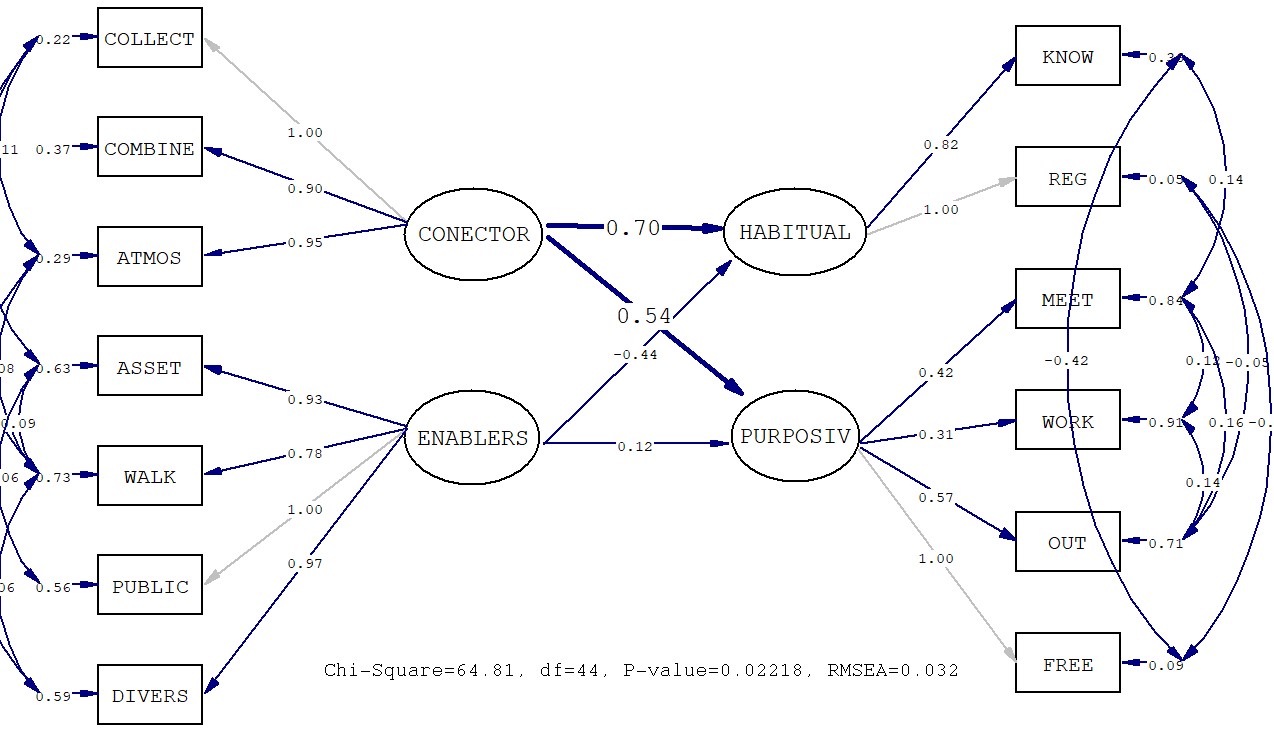Magnetizing Creative Talent: The Influences of Creative Ecology on Spatial Behavior of Creative Class in Charoen Krung District
Main Article Content
Abstract
The objective of this research is to find the components of the spatial behavior and the creative ecology in Charoen Krung district, and develop the relationship model between the two variables. The research methods used are both qualitative and quantitative techniques to analyze both the exploratory and second-order confirmatory factor analysis of 450 creative people data collected, and develop the relationship between variables by analyzing the Structural Equation Model. The results of the research showed that the spatial behavior of creative people can be divided into 2 characteristics which are (1) the habitual usage, and (2) the purposive usage. The creative ecology is divided into 2 types which are (1) the area that directly connects work and creative business activities (connectors), and (2) the areas that encourage creative activities (enablers). The study of the influence of the creative ecology that effect creative people’s behavior found that all spatial behaviors are significantly influenced from the connector group, and did not found a significant influence on the enablers group. Those involved in the development of the creative district can apply these findings to prioritize development that is consistent with the demand of creative users who are key users.
Downloads
Article Details

This work is licensed under a Creative Commons Attribution-NonCommercial-NoDerivatives 4.0 International License.
All material is licensed under the terms of the Creative Commons Attribution 4.0 International (CC-BY-NC-ND 4.0) License, unless otherwise stated. As such, authors are free to share, copy, and redistribute the material in any medium or format. The authors must give appropriate credit, provide a link to the license, and indicate if changes were made. The authors may do so in any reasonable manner, but not in any way that suggests the licensor endorses you or your use. The authors may not use the material for commercial purposes. If the authors remix, transform, or build upon the material, they may not distribute the modified material, unless permission is obtained from JARS. Final, accepted versions of the paper may be posted on third party repositories, provided appropriate acknowledgement to the original source is clearly noted.
References
Janjamlah, T., & Kaewlai, P. (2018). Spatial Behavior in Creative Workplace: Mapping Creative and InnovativeBehavior in Office Environment. Journal of Architectural/Planning Research and Studies (JARS), 15(1), 97-112.
Kaewlai, P., & Janjamlah, T. (2018). The New Public Learning Environment: the paradigm shifts in learning and its impact on program, space, and architecture of contemporary knowledge center. Journal of Architectural/Planning Research and Studies (JARS), 15(2), 135-152.
Creative Coalition Auckland and Elise Sterback. (2014). Creative Ecology: a new model for resilience in creative communities. Living Document - version 1 March 2014. Retrieved from http://www.communityresearch.org.nz/wp-content/uploads/formidable/Creative-Ecology-Living-Doc-V1.2-_-Elise-Sterback-1.pdf
Cunda, I. V. d., & Selada, C. (2009). Creative urban regeneration: the case of innovation hubs. International Innovation and Regional Development, 1(4), 371-386.
Groves, K., & Marlow, O. (2017). Spaces for Innovation: The Design and Science of Inspiring Environments. Amsterdam: Frame Publishers.
Howkins, J. (2010). Creative Ecologies: Where Thinking Is A Proper Job, 43. USA: Transaction Publishers.
Jackson, N. (2016). Exploring Learning Ecologies. Lifewide education. Retrieved from https://www.academia.edu/24212964/Exploring_Learning_Ecologies
Kopec, D. (2006). Environmental Psychology for Design. United Kingdom: Fairchild Books.
Richards, G., & Wilson, J. (Ed.). (2007). Tourism, creativity and development. Oxfordshire: Routledge.
Zenker, S. (2009). Who’s your target? The creative class as a target group for place branding. Journal of Place Management and Development, 2(1), 23-32.
Zenker, S., Peterson, S., & Aholt, A. (2013). The Citizen Satisfaction Index (CSI): Evidence for a four basic factor model in a German sample. Cities 31(2013), 156-164.


